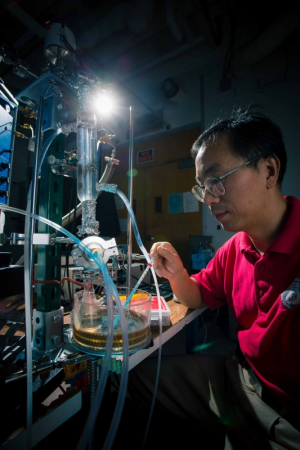Sunlight and water are plentiful and cheap, especially when compared to resources like petroleum. That’s why a recent finding by Jiming Bao, his group and collaborators is so important.
Bao is an assistant professor of electrical and computer engineering with the University of Houston Cullen College of Engineering. In the latest issue of Nature Nanotechnology, he outlines his work with nanoparticles that can efficiently split water into hydrogen and oxygen. Simply disperse them in water then expose them to sunlight. Since hydrogen itself is a clean and efficient fuel – whether burned or used in fuel cells to generate electricity – such a finding could drastically alter the energy landscape.
“Sunlight is the most abundant energy,” said Bao. “If you can combine water and sunlight to make hydrogen then you can solve the energy problem.”
Bao’s nanoparticles are made of cobalt monoxide and measure just five to 10 billionths of a meter in size. Particles larger than this won’t split water, said Bao, but at the nanoscale, the material’s electrochemical properties change.
Specifically, cobalt monoxide’s band edge position – essentially, the property that determines its ability to add or remove electrons from water molecules – shifts. When light hits a nanoparticle, it creates electrons as well as holes, which are spaces where an electron should be. The electrons move to the particle surface, and convert water to hydrogen. Specifically, electrons are transferred to positively charged hydrogen ions, which reduce them to H2 molecules.
At the same time, the holes combine with the electrons in leftover hydroxide ions (one hydrogen and one oxygen along with an extra electron), generating O2 and H2. The combination allows the second hydrogen atom to split off from the oxygen.
Water splitting materials, Bao said, are not unheard of. What makes this so important is how much hydrogen these particles generate in comparison: up to 50-times more than existing catalysts. That’s the type of figure that can alter the energy industry’s landscape.
But there is one major drawback to these particles that will prevent them from having an immediate impact: they only work for an hour. After that, their ability to split water drops rapidly. From a logistical standpoint, this makes them impractical to use on a commercial scale.
Still, the finding proves that highly efficient water splitting is possible. That alone is a major advance. “We’ve shown it’s possible to do energy conversion at such high efficiency,” said Bao. “The next step is to engineer the material to increase its lifetime. Now we have to come up with ways to regenerate it or redesign it so it will last longer.”
